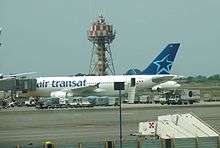Air Transat Flight 961
 C-GPAT, the aircraft involved, shown at Rome Fiumicino in 2011 | |
| Accident summary | |
|---|---|
| Date | March 6, 2005 |
| Summary | Structural failure of the Rudder in flight due to a stress fracture |
| Site | Juan Gualberto Gomez Airport, Cuba |
| Passengers | 262 |
| Crew | 9 |
| Fatalities | 0 |
| Injuries (non-fatal) | 0 |
| Survivors | 271 (all) |
| Aircraft type | Airbus A310-308 |
| Operator | Air Transat |
| Registration | C-GPAT[1] |
| Flight origin | Juan Gualberto Gomez Airport, Varadero, Cuba |
| Destination | Jean Lesage Airport, Quebec, Quebec, Canada |
Air Transat Flight 961 was an Air Transat flight from Varadero, Cuba to Quebec City, Canada on March 6, 2005. The aircraft experienced a structural failure in which the rudder detached in flight. The flight crew were able to regain enough control of the aircraft to return safely to Varadero. As of March 2016, the Airbus A310-308 is still in service with Air Transat.
The investigation that followed determined that the manufacturer's inspection procedure for the composite rudder was not adequate.[2] Inspection procedures for composites structures on airliners were changed because of this accident.
Event
Flight 961 was a routine scheduled commercial flight carrying 262 passengers and 9 crew from Varadero, Cuba to Quebec City on March 6, 2005. At 2:48 am EST, flight 961 took off from Cuba. The flight climbed to its initial cruising altitude of 35,000 ft (11,000 m) and the flight attendants began the inflight service. Then, suddenly, at 3:02 am, the aircraft began a dutch roll after a bang shuddered the aircraft violently. The plane climbed until the crew overcame the aircraft upset by descending. The aircraft attempted to divert to Fort Lauderdale-Hollywood International Airport but Air Transat operations told the crew that returning to Varadero would be the more prudent option. There were no warnings on the flightdeck indicating a rudder problem or a yaw damper problem. The plane landed safely at 4:19 am. Upon parking at the gate, the crew did another walk around inspection to narrow down the cause of the accident. The inspection revealed the entire rudder had broken away from the vertical stabilizer of the aircraft.[2]
Cause
Although most of the cockpit voice recorder and flight data recorder were erased due to the long span of time in which the accident occurred, there were several findings as to the cause of the accident. The aircraft probably had a stress fracture in the tail that went unnoticed for several flights prior to the accident flight and the A310 does not have a mechanism in the tail that suspends the growth of the fracture(s).[2]
The Transportation Safety Board found that inspection program of composite rudders was inadequate.[3] In particular, the durability of the rudder was questioned. Air Transat Flight 961 provided new insights into rudder problems on Airbus A300-600, Airbus A300-600R, and Airbus A310 aircraft.
Aftermath
The accident aircraft, fin number 303, is still flying with Air Transat as of March 2016.
See also
References
- ↑ "Canadian Civil Aircraft Register". Transport Canada.
- 1 2 3 "Report Number A05F0047" (PDF). Transportation Safety Board of Canada (TSB). 2007-11-22. Retrieved 2008-08-26.
- ↑ "Airbus inspection program inadequate at time of incident: Board". Toronto Star. November 23, 2007.
External links
- "A310 Loses Rudder, Prompts Fleetwide Inspections, Inquiry". Aviation Today. March 21, 2005.
- Rose, David (March 31, 2005). "What made an Airbus rudder snap in mid-air?". The Guardian.
- "Accident Photo Gallery: Air Transat Flight 961". AirDisaster.Com. Archived from the original on 2014-12-30.